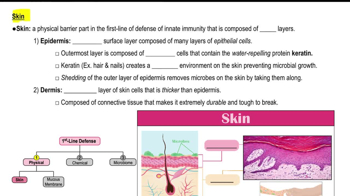Here are the essential concepts you must grasp in order to answer the question correctly.
Burn Classification
Burns are classified into three degrees based on their severity. First-degree burns affect only the outer layer of skin, causing redness and pain. Second-degree burns involve the epidermis and part of the dermis, leading to blisters and swelling. Third-degree burns penetrate deeper, damaging all layers of skin and potentially affecting underlying tissues. Understanding this classification helps in assessing the need for medical interventions like skin grafts.
Recommended video:
Introduction to Classification of Joints
Skin Grafts
A skin graft is a surgical procedure where skin is transplanted to cover a wound or burn area. This is typically necessary for third-degree burns or extensive second-degree burns that do not heal properly. The graft can be taken from the patient’s own body (autograft) or from a donor (allograft). The decision to use a skin graft depends on the burn's depth, size, and healing potential.
Recommended video:
Healing Process of Burns
The healing process for burns varies based on their severity. Second-degree burns usually heal within two to three weeks, often without significant scarring, but they can lead to complications if not properly managed. Factors such as infection, the patient's overall health, and the burn's location can influence healing. Understanding this process is crucial for determining whether a skin graft is necessary.
Recommended video:
Clot Retraction & Fibrinolysis
 Verified step by step guidance
Verified step by step guidance


